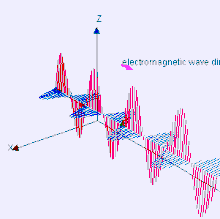Broadly, a wave is simply a quantity that changes in a periodic way over space and/or time.
In the case of a water wave, the changing quantity is the distance through which the surface is displaced- or, if you like, just the height of the surface.
With a wave on a string, the changing quantity is the displacement of the string from its resting position.
With a sound wave, the changing quantity is air pressure.
The frequency of a wave is the number of times per second that the changing quantity oscillates. The wavelength is the distance between successive occurrences of maximum or minimum values of the changing quantity.
With electromagnetic waves, the changing quantity is the strength of the electric and magnetic fields that permeate space. If you are happy with the idea of an electric field, for example, then you can think of the wave as being a periodic fluctuation in the strength of the field at every point.
All particles seem to have a wave-like aspect (the particle wave duality you mentioned). In the case of those waves, the changing quantity, very loosely speaking, is a measure of the probability that the particle will be found at a particular point.
Strictly speaking, the idea of a pure wave with a precise frequency and wavelength everywhere in space is a bit of a fiction. In reality waves tend to be less uniform than that, and their properties can become very difficult to model precisely.

